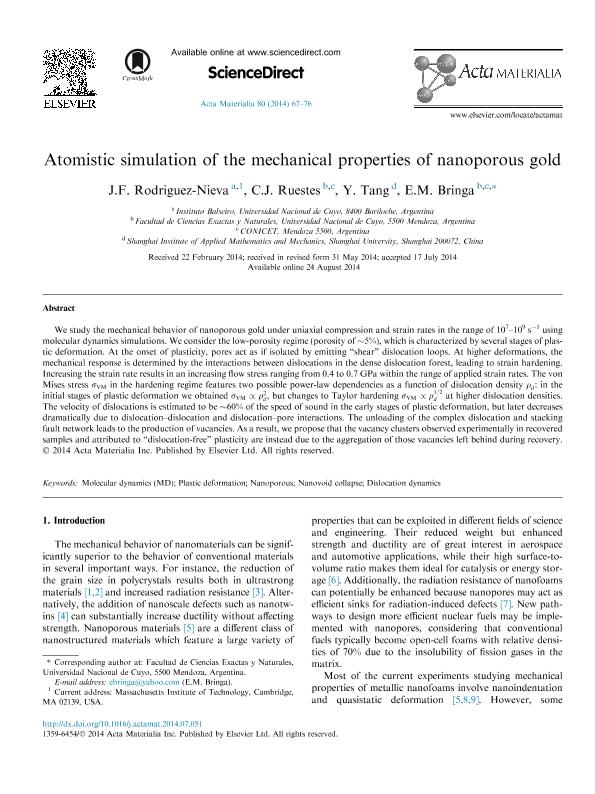Artículo
Atomistic simulation of the mechanical properties of nanoporous gold
Fecha de publicación:
08/2014
Editorial:
Elsevier
Revista:
Acta Materialia
ISSN:
1359-6454
Idioma:
Inglés
Tipo de recurso:
Artículo publicado
Clasificación temática:
Resumen
7–109 s−1 using molecular dynamics simulations. We consider the low-porosity regime (porosity of ∼5%), which is characterized by several stages of plastic deformation. At the onset of plasticity, pores act as if isolated by emitting “shear” dislocation loops. At higher deformations, the mechanical response is determined by the interactions between dislocations in the dense dislocation forest, leading to strain hardening. Increasing the strain rate results in an increasing flow stress ranging from 0.4 to 0.7 GPa within the range of applied strain rates. The von Mises stress σVM in the hardening regime features two possible power-law dependencies as a function of dislocation density ρd: in the initial stages of plastic deformation we obtained σVM∝ρd2, but changes to Taylor hardening σVM∝ρd1/2 at higher dislocation densities. The velocity of dislocations is estimated to be ∼60% of the speed of sound in the early stages of plastic deformation, but later decreases dramatically due to dislocation–dislocation and dislocation–pore interactions. The unloading of the complex dislocation and stacking fault network leads to the production of vacancies. As a result, we propose that the vacancy clusters observed experimentally in recovered samples and attributed to “dislocation-free” plasticity are instead due to the aggregation of those vacancies left behind during recovery.
Archivos asociados
Licencia
Identificadores
Colecciones
Articulos(CCT - MENDOZA)
Articulos de CTRO.CIENTIFICO TECNOL.CONICET - MENDOZA
Articulos de CTRO.CIENTIFICO TECNOL.CONICET - MENDOZA
Citación
Bringa, Eduardo Marcial; Tang, Yizhe; Ruestes, Carlos Javier; Rodriguez Nieva. J. F.; Atomistic simulation of the mechanical properties of nanoporous gold; Elsevier; Acta Materialia; 80; 8-2014; 67-76
Compartir
Altmétricas




